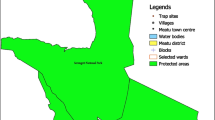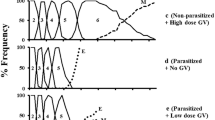Abstract
Laboratory-reared tsetse, Glossina pallidipes were inoculated with the tsetse virus by microinjection into the haemocoel, and feeding through micropipettes. The inoculated tsetse were reared on rabbits for 45 days, and feeding, flight and mating activities recorded. The tsetse were dissected and the conditions of the salivary glands and gonads noted. In males, tsetse were examined under a compound microscope and the presence of spermatozoa noted. F1 pupae were allowed to emerge, dissected, and the salivary glands examined for hypertrophy, and the gonads for sterility.
There was no reduction in the activity of inoculated tsetse. Infection level was 23.5% in the treated adults. All infected ♂♂ were sterile while ♀♀ were fertile. There was no significant difference in the maternal age at larviposition, F1 pupal weight, or incubation period of F1 pupae, between treated and untreated tsetse.
A high proportion of F1 adults (65%) were infected, with category four hypertrophied salivary glands. All males with enlarged glands were sterile. The evidence obtained shows that the tsetse virus may be used in biological control of G. pallidipes.
Résumé
Des tsé-tsé Glossina pallidipes élevées au laboratoire ont été inoculées avec le virus de tsé-tsé par micro-injection dans le sang et par alimentation par micropipettes. Les tsé-tsé inoculées furent elevées sur des lapins pendant 45 jours et leurs activités relatives â l’alimentation, au vol et accouplement furent enregistrées. Les tsé-tsé furent disséquées et l’etat des glandes salivaires et gonades relevé. Après leur emergence les chrysalides de la génération F1 etaient dissequées; leurs glandes salivaires et gonades examinées pour hypertrophie et sterilité.
Il n’y avait pas de reduction de l’activité chez les tsé-tsé inoculées. Chez les adultes traités, le niveau d’infection était de 23,5%. Tous les mâles infectés étaient steriles par contre les femelles fertiles. Il n’y a pas eu de difference significative dans l’âge de femelles à la larviposition, le poids des nymphes F1, ou la durée d’incubation des nymphes F1 entre les tsé-tsé traitées celles qui ne l’étaient pas. Une importante proportion des adultes à la génération F1 infectés avaient des glandes salivaires hypertrophiées tombant dans la catégorie 4. Tous les mâles ayant des glandes hypertrophiées étaient steriles. Il a été demontréque le virus de tsé-tsé puisse être utilisé dans la lutte biologique contre G. pallidipes.
Similar content being viewed by others
References
Challier A., Eyraud M., Lafaye A. and Laveissiere C. (1977) Amélioration du rendement du piège biconique pour glossines (Diptera, Glossinidae) par l’emploi d’un cone supérieur bleu. Cah. ORSTOM, sér. Ent. méd. Parasitol. 15, 283–286.
FAO/IAEA (1981) Application of the sterility principle for tsetse fly eradication or control. At. Energy Rev. 10.
Gouteux J.-P. (1987) Prevalence of enlarged salivary glands in Glossina palpalis, G. pallicera, and G. nigrofusca (Diptera: Glossinidae) from the Vavoua area, Ivory Coast. J. Med. Ent. 24, 11.
Jaenson T. G. T. (1978) Virus-like rods associated with salivary gland hyperplasia in tsetse Glossina pallidipes. Trans. R. Soc. trop. Med. Hyg. 72, 234–238.
Jaenson T. G. T. (1986) Sex ratio distortion and reduced lifespan of Glossina pallidipes infected with the virus causing salivary gland hyperplasia. Ent. exp. appl. 41, 265–271.
Marschall K. J. (1980) Coconuts. In Proceedings of Workshops in Insect Pest Management with Microbial Agents: Recent Achievements, Deficiencies, and Innovations, IPRC. Ithaca, New York.
Mews A. R., Baumagartner H., Lugar D. and Offori E. D. (1976) Colonization of Glossina morsitans morsitans West. (Diptera, Glossinidae) in the laboratory using in vitro techniques. Bull. ent. Res. 65, 631–642.
Mews A. R., Langley P. A., Pimpley R. W. and Flood M. E. T. (1977) Large-scale rearing of tsetse flies (Glossina spp.) in the absence of a living host. Bull. ent. Res. 67, 119–128.
Odindo M. O. (1982) Incidence of salivary gland hypertrophy in field populations of the tsetse Glossina pallidipes on the south Kenya coast. Insect Sci. Applic. 3, 59–64.
Odindo M. O. and Amutalla P. A. (1986) Distribution pattern of the virus of Glossina pallidipes Austen in a forest ecosystem. Insect Sci. Applic. 7, 79–84.
Odindo M. O., Payne C. C., Crook N. E. and Jarrett P. (1986) Properties of a novel DNA virus from the tsetse fly (Glossina pallidipes). J. gen. Virol. 67, 527–536.
Odindo M. O., Sabwa D. M., Amutalla P. A. and Otieno W. A. (1981) Preliminary tests on the transmission of virus-like particles to Glossina pallidipes. Insect Sci. Applic. 2, 219–221.
Otieno L. H., Kokwaro E. D., Chimtawi M. and Onyango P. (1980) Prevalence of enlarged salivary glands in wild populations of Glossina pallidipes in Kenya with a note on the affected organ. J. Invertebr. Pathol. 36, 113–118.
Payne C. C. (1982) Insect viruses as control agents. Parasitology 84, 35–77.
Author information
Authors and Affiliations
Rights and permissions
About this article
Cite this article
Odindo, M.O. Glossina pallidipes Virus: Its Potential for Use in Biological Control of Tsetse. Int J Trop Insect Sci 9, 399–403 (1988). https://doi.org/10.1017/S1742758400006408
Received:
Revised:
Published:
Issue Date:
DOI: https://doi.org/10.1017/S1742758400006408




